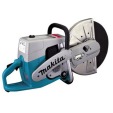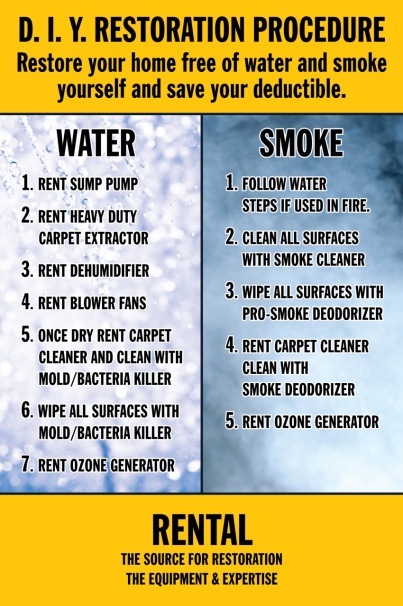Does your concrete project require more finesse than simply breaking up the concrete with a jackhammer? A cut-off saw, floor saw or concrete chainsaw may be the answer. All three items provide the capability of cutting concrete and in some instances asphalt with control and precision. Let’s take a look the capabilities of the different concrete saws available for rent.
Cut-Off Saws
For most concrete cutting jobs, the cut-off saw is a popular choice. These hand-held saws can be used to cut concrete, asphalt and metal. Cut-off machines resemble a chainsaw, however they have a circular blade instead of a chain and bar. Typically available in 12-inch or 14-inch blade sizes, cut-off saws can be powered by a two-stroke gasoline engine or an electric motor. Abrasive (silicon carbide material) or diamond- rimmed blades are the most common saw blades for cutting concrete. Both blades are used to cut or score concrete, with our 14-inch (blade diameter) cut-off saws able to cut up to four inches deep. When used to “score” concrete, the “score line” allows for a nice cut-line when breaking out a concrete section.
Concrete Chain Saws
 If you need to cut an opening deeper than 5-inches, you might want to consider a concrete chainsaw for your job. Our concrete chainsaws have a 12-inch bar and work great for cutting out openings in concrete for plumbing, electrical components, windows and more. This saw is also designed like a chainsaw using a power head, guide bar and diamond chain. A two-stroke gasoline engine powers our concrete chainsaws and the saws use a chain that incorporates diamond segments that are laser welded to the chain in place of the cutting teeth typically found on a wood chainsaw. The diamond segments create a grinding action that wears away the concrete. This grinding action creates a very safe cutting operation with no kickback and each chain will cut from 30-feet to 60-feet of concrete.
If you need to cut an opening deeper than 5-inches, you might want to consider a concrete chainsaw for your job. Our concrete chainsaws have a 12-inch bar and work great for cutting out openings in concrete for plumbing, electrical components, windows and more. This saw is also designed like a chainsaw using a power head, guide bar and diamond chain. A two-stroke gasoline engine powers our concrete chainsaws and the saws use a chain that incorporates diamond segments that are laser welded to the chain in place of the cutting teeth typically found on a wood chainsaw. The diamond segments create a grinding action that wears away the concrete. This grinding action creates a very safe cutting operation with no kickback and each chain will cut from 30-feet to 60-feet of concrete.
While similar to a concrete cut-off saw, a concrete chainsaw is designed to plunge nose first into the concrete and has the ability to cut more than twice as deep as a 14-inch cut-off saw. Concrete chainsaws provide a deeper cut with no over-cut, allowing you to make square corners, which is not possible with a cut-off saw. They can be used to make openings as small as 4-inches by 4-inches and to cut odd shapes and sizes.
For more tips and information on our ICS chainsaws, check out the ICS website, http://icsbestway.com/en/tech/index.aspx
Concrete Floor Saws
 Walk-behind concrete saws or “floor saws” are used to cut sections of flooring or similar flat sections. Our 14-inch saws will cut up to a depth of 4-inches. This type of saw can be used for scoring concrete for slab removal with a jackhammer, making expansion cuts to new concrete slabs, and cutting asphalt. These saws are gasoline powered and similar to the cut-off machines use either a silicon carbide abrasive blade or a diamond-rimmed blade.
Walk-behind concrete saws or “floor saws” are used to cut sections of flooring or similar flat sections. Our 14-inch saws will cut up to a depth of 4-inches. This type of saw can be used for scoring concrete for slab removal with a jackhammer, making expansion cuts to new concrete slabs, and cutting asphalt. These saws are gasoline powered and similar to the cut-off machines use either a silicon carbide abrasive blade or a diamond-rimmed blade.
Diamond Blades vs. Abrasive Blades
As mentioned above, you have the option of using either an abrasive blade or a diamond blade when using a hand held cut-off saw or a walk-behind concrete saw. The abrasive blades work well for small cutting jobs in concrete, asphalt, or even metal. The downside to abrasive blades is that they wear as you use them (similar to a grinding wheel) so the blade life is much less than the life of a diamond blade. Diamond blades allow for a faster cut and offer a constant cutting depth. They are available for purchase or rent and are a much better value if your job requires a significant amount of cutting. While we have dry-cut blades available, most of our diamond blades are “wet-cut” requiring water to keep the blade cool (which extends blade life) and the dust down.
Safety First
With any project safety comes first. The cutting of any material using power tools creates dust and flying chips. We recommend the use of safety glasses with side shields or safety goggles, work gloves, a work apron or close fitting clothing, hearing protection, and an approved dust/mist respirator.

